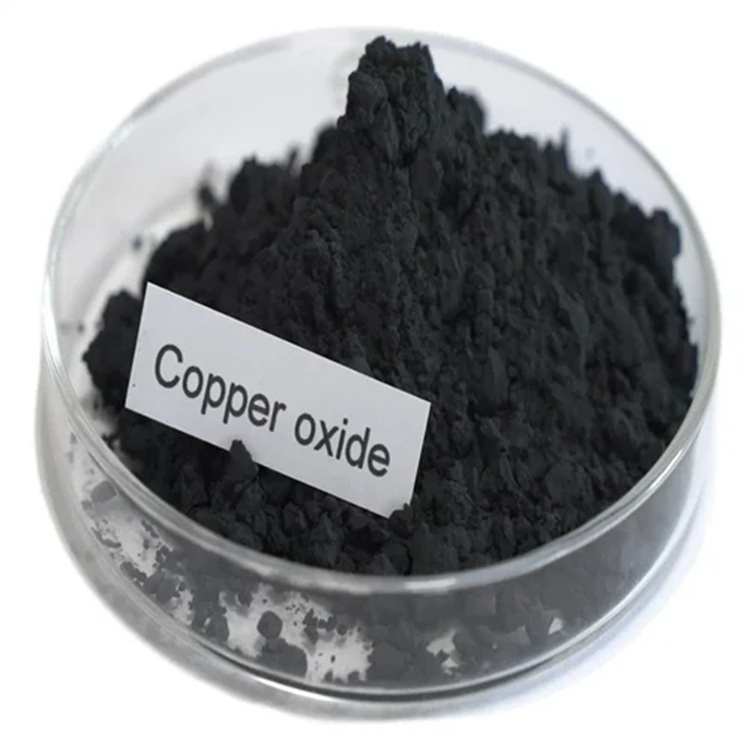We unleash your business potential by maximize the business innovation.
Send EmailCupric Oxide, Copper Oxide, Tenorite, 1317‑38‑0
🧪 Copper(II) Oxide (CuO)
Copper(II) oxide, also known as Cupric oxide or Tenorite, is an inorganic compound of copper and oxygen. It is a black solid widely used in ceramics, glass, catalysts, metallurgy, and electronics.
1️⃣ Chemical Identity
-
Chemical Name: Copper(II) Oxide
-
Formula: CuO
-
Molecular Weight: 79.55 g/mol
-
CAS Number: 1317-38-0
-
EC Number: 215-269-1
-
Appearance: Black crystalline powder
-
Crystal Structure: Monoclinic (Tenorite)
-
Density: ~6.31 g/cm³
-
Melting Point: ~1,320 °C
-
Boiling Point: ~2,000 °C
-
Solubility: Insoluble in water; soluble in acids and ammonium hydroxide
2️⃣ Physical & Chemical Properties
-
Color: Black solid (distinct from red Cu₂O).
-
Reactivity: Reacts with acids to form copper(II) salts (e.g., CuCl₂, CuSO₄).
-
Thermal Stability: Stable at room temperature; decomposes at very high temperatures.
-
Magnetic Properties: Antiferromagnetic below 213 K.
3️⃣ Applications
-
Ceramics & Glass:
-
Pigment and colorant (black, blue, green hues).
-
Used in glazes and enamels.
-
-
Catalysis:
-
Catalyst in organic reactions and gas purification.
-
-
Metallurgy:
-
Intermediate in copper refining and alloy production.
-
-
Electronics:
-
Semiconductor applications; thin films for sensors.
-
-
Chemistry:
-
Precursor for other copper compounds.
-
4️⃣ Synonyms
-
Copper Oxide
-
Cupric Oxide
-
Tenorite
-
CuO
5️⃣ Safety & Handling
-
Toxicity: Harmful if ingested or inhaled; may cause irritation.
-
Precautions: Gloves, goggles, and dust masks recommended.
-
Storage: Keep in dry, sealed containers; protect from moisture.
-
Waste Disposal: Follow hazardous waste regulations.
📌 Summary: Copper(II) Oxide (CAS 1317-38-0) is a black crystalline compound with ceramic, glass, catalytic, metallurgical, and electronic applications, making it a versatile industrial material.
📑 Quick Facts
-
CAS No: 1317‑38‑0
-
Chemical Formula: CuO
-
Molecular Weight: 79.55 g/mol
-
Density: ~6.31 g/cm³
-
Melting Point: ~1326 °C
-
Packaging Types: 25 kg bags, drums, laboratory bottles
-
HS Code: 2825.50 (copper oxides)
⚙️ Technical Properties
-
Appearance: Black crystalline powder
-
Solubility: Insoluble in water; soluble in acids
-
Crystal Structure: Monoclinic
-
Purity Grades: 98–99.9% (industrial and high‑purity grades)
🏭 Applications
-
Ceramics & Glass: Pigment (black, blue‑green tones), enamels, glazes
-
Metallurgy: Precursor for copper salts and alloys
-
Catalysis: Used in organic synthesis and petrochemical catalysts
-
Electronics: Semiconductor material, superconducting ceramics (e.g., YBCO systems)
-
Chemicals: Intermediate for copper‑based compounds
🔬 Production Methods / Sources
-
Thermal oxidation of copper metal or copper(II) nitrate
-
Calcination of copper(II) hydroxide
-
Industrial roasting of copper ores
📊 Sector Suitability Table
| Sector | Suitability | Notes |
|---|---|---|
| Ceramics & Glass | ✔ | Pigments and glaze applications |
| Metallurgy | ✔ | Precursor for copper salts/alloys |
| Catalysis | ✔ | Organic synthesis, petrochemical catalysts |
| Electronics | ✔ | Semiconductors, superconducting ceramics |
| Food/Cosmetics | ✖ | Heavy metal oxide, not permitted |
🧾 Other Names
-
Cupric oxide
-
Copper(II) oxide
-
Tenorite (mineral form)
🛡️ Safety & MSDS Summary
-
GHS Pictograms: ⚠️ Irritant, 🌍 Environmentally hazardous
-
Storage: Dry, sealed packaging; avoid moisture
-
PPE: Gloves, goggles, dust mask/respirator
-
Waste: Heavy metal oxide waste; dispose via licensed facilities
🌍 Market & Commercial Information
-
Purity Grades: 98%, 99%, 99.9%
-
Packaging: 25 kg bags, 50 kg drums, 1000 kg IBCs
-
Producer Regions: China, India, Europe, USA
-
Trade Names: CuO, Tenorite
🧪 Quality & Analytical Data
-
Tests: ICP‑OES (trace metals), XRD (phase analysis), BET (surface area), particle size distribution
-
Forms: Powder, nanopowder, granules
🌱 Environmental & Sustainability Aspects
-
Waste Management: Heavy metal oxide; requires controlled disposal
-
Recycling: Recoverable from copper scrap and spent catalysts
-
Carbon Footprint: Moderate; depends on copper mining and refining
